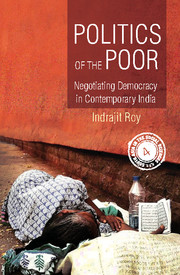Book contents
- Frontmatter
- Contents
- List of Tables, Map and Charts
- Acknowledgements
- Glossary
- Acronyms
- Introduction: Against False Binaries
- 1 The Perspectives of the Study: Towards an Agonistics of Democracy
- 2 Political Spaces: Institutional Opportunity Structures
- 3 Political Spaces: Social Relations of Power
- 4 From Clientelism to Citizenship?: The Politics of Supplications
- 5 From Moral Vocabularies to Languages of Stateness?: The Politics of Demands
- 6 From Backwardness to Improvement?: The Politics of Disputation
- 7 From Tradition to Modernity?: The Politics of Imagination
- Conclusion: The Politics of the Poor: Agonistic Negotiations with Democracy
- Annexure 1 The Dramatis Personae, 2009–10
- Annexure 2 The Census Survey
- Annexure 3 The Multidimensional Poverty Index
- Annexure 4 Schedule for BPL Census 2002
- Annexure 5 Schedule for BPL Census 2002 West Bengal
- Annexure 6 BPL Cutoff List for West Bengal
- Bibliography
- Index
Annexure 3 - The Multidimensional Poverty Index
Published online by Cambridge University Press: 03 August 2019
- Frontmatter
- Contents
- List of Tables, Map and Charts
- Acknowledgements
- Glossary
- Acronyms
- Introduction: Against False Binaries
- 1 The Perspectives of the Study: Towards an Agonistics of Democracy
- 2 Political Spaces: Institutional Opportunity Structures
- 3 Political Spaces: Social Relations of Power
- 4 From Clientelism to Citizenship?: The Politics of Supplications
- 5 From Moral Vocabularies to Languages of Stateness?: The Politics of Demands
- 6 From Backwardness to Improvement?: The Politics of Disputation
- 7 From Tradition to Modernity?: The Politics of Imagination
- Conclusion: The Politics of the Poor: Agonistic Negotiations with Democracy
- Annexure 1 The Dramatis Personae, 2009–10
- Annexure 2 The Census Survey
- Annexure 3 The Multidimensional Poverty Index
- Annexure 4 Schedule for BPL Census 2002
- Annexure 5 Schedule for BPL Census 2002 West Bengal
- Annexure 6 BPL Cutoff List for West Bengal
- Bibliography
- Index
Summary
Following Alkire and Foster (2011), I use the concept of the MPI to encapsulate the diverse manifestations of poverty. The MPI uses ten indicators to measure three critical dimensions of poverty at the household level: education, health and living standard. The three dimensions are equally weighted, although the weightage assigned to the indicators varies. To elaborate:
1. The dimension of ‘education’ comprises the following indicators, each weighted equally at 1/6
a. Years of schooling: The household was considered deprived if no household member completed five years of schooling.
b. School attendance: The household was considered deprived if any child aged 6–14 was not attending school.
2. The dimension of ‘health’ comprises the following indicators, each weighted equally at one-sixth.
a. Child mortality: The household was considered deprived if any child aged five years or less had died in the family within the last five years.
b. Nutrition: The household was considered deprived if anyone in the household reported that there were times when they ate fewer meals than usual or when they reported not knowing in the morning whether they would be able to afford a meal in the evening.
3. The dimension of ‘standard of living’ comprises the following indicators, each weighted equally at one-eighteenth.
a. Electricity: The household was considered deprived if it had no legal access to electricity.
b. Drinking water: The household was considered deprived if it did not have access to safe drinking water.
c. Sanitation: The household was considered deprived if it did not have their own improved sanitation.
d. Flooring: The household was considered deprived if the house it inhabited had a dirt, sand or dung floor.
e. Fuel: The household was considered deprived if it used wood, charcoal or dung for cooking.
f. Assets: The household was considered deprived if it did not own more than one of: radio, TV, telephone, motorized vehicle, or refrigerator.
A household was identified as ‘multi-dimensionally poor’, or MPI Poor, if it was deprived in at least one dimension, or in a combination of indicators that added up to at least one dimension.
- Type
- Chapter
- Information
- Politics of the PoorNegotiating Democracy in Contemporary India, pp. 441 - 442Publisher: Cambridge University PressPrint publication year: 2017



